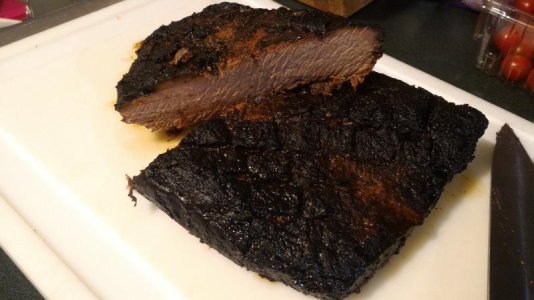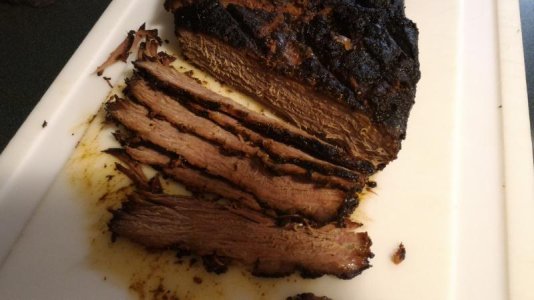RJ_Make
Knows what a fatty is.
- Joined
- May 6, 2017
- Location
- Annapoli...
Sorry for the long post, but I'm at wits end here...
So apparently I'm 'just not getting it'. I'm new to Kamado cooking (4 months) (coming from a cheap electric Masterbuilt smoker), and just can't seem to get juicy beef (chicken & pork seems ok)
The Problem(s)
Dry Beef
The first and most important, all of my beef cooks are coming out on the dry side (it's tender and tasty).
Smoke Not Lasting Very Long
The second is I can't seem to keep the wood smoking for very long, maybe a couple of hours at most. When I inspect the coals after a cook, I notice that much of the wood is still present and only half burnt (the section closest to the hot coals)
Since adding wood, or even resetting the un-burnt pieces is such a pain on the Kamado style grill, I really need some advice on how to get the smoke to last longer.
Grill Setup
As mentioned, using a Vision classic B w/ash drawer. I'm layering wood and charcoal in an attempt to get even smoke through out the cook.
Using the Vision ceramic deflector; drip pan on first rack level (generally filled with fluid of some nature) then the food on the second level.
On long cooks, I also use the Rocks Stoker. Not that it matters, but I thought I would mention it.
Cook Example
So lets take the Brisket I did today as an example. This was a Sams Club Angus Beef USDA Choice Flat (~7lbs). Prepped 8 hrs ahead with my favorite rub. Morning; started grill (250F) while letting brisket come up to room temp.
When meat hit 165-170 double wrapped in foil. Checked at 195, probed and didn't feel ready, probed at 203, almost but just not quite yet. Probed again at 205 and felt really good. Probed in at least 5 -8 different area's
Pulled and wrapped in towel and placed in the cooler for another hour.
Meat is tender and tasty, but dry and this is the case for everything beef I've cooked on this grill.
Could it be the quality of the meat I'm getting? It's just a bit disappointing I can't seem to get this grill to work as well as my old Masterbuilt.
Anyway, I'm sure it's me and something I'm doing or not doing so any advice is much appreciated. and thanks for reading this saga of a post..
So apparently I'm 'just not getting it'. I'm new to Kamado cooking (4 months) (coming from a cheap electric Masterbuilt smoker), and just can't seem to get juicy beef (chicken & pork seems ok)
The Problem(s)
Dry Beef
The first and most important, all of my beef cooks are coming out on the dry side (it's tender and tasty).
Smoke Not Lasting Very Long
The second is I can't seem to keep the wood smoking for very long, maybe a couple of hours at most. When I inspect the coals after a cook, I notice that much of the wood is still present and only half burnt (the section closest to the hot coals)
Since adding wood, or even resetting the un-burnt pieces is such a pain on the Kamado style grill, I really need some advice on how to get the smoke to last longer.
Grill Setup
As mentioned, using a Vision classic B w/ash drawer. I'm layering wood and charcoal in an attempt to get even smoke through out the cook.
Using the Vision ceramic deflector; drip pan on first rack level (generally filled with fluid of some nature) then the food on the second level.
On long cooks, I also use the Rocks Stoker. Not that it matters, but I thought I would mention it.
Cook Example
So lets take the Brisket I did today as an example. This was a Sams Club Angus Beef USDA Choice Flat (~7lbs). Prepped 8 hrs ahead with my favorite rub. Morning; started grill (250F) while letting brisket come up to room temp.
When meat hit 165-170 double wrapped in foil. Checked at 195, probed and didn't feel ready, probed at 203, almost but just not quite yet. Probed again at 205 and felt really good. Probed in at least 5 -8 different area's
Pulled and wrapped in towel and placed in the cooler for another hour.
Meat is tender and tasty, but dry and this is the case for everything beef I've cooked on this grill.
Could it be the quality of the meat I'm getting? It's just a bit disappointing I can't seem to get this grill to work as well as my old Masterbuilt.
Anyway, I'm sure it's me and something I'm doing or not doing so any advice is much appreciated. and thanks for reading this saga of a post..
Attachments
Last edited:







